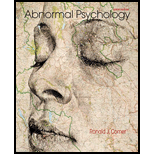
Concept introduction
Acute stress disorder (ASD) and post-traumatic stress disorder (PTSD) are characterized by intense feelings of anxiety that are triggered by one or more stressful events. The aspects that they differ on are the duration of the disorders and the time of onset.
Explanation of Solution
Answer and explanation
ASD and PTSD occur in response to some traumatic or terrifying event. Various events can lead to the development of these disorders. Some of them are as follows:
Combat: One of the leading causes of PTSD and ASD is warfare. Military personnel deployed to active war zones face a lot of violence. As a result, many of them show signs of distress during their deployment (called shell-shock), while some come back and develop PTSD or ASD.
Terrorism: Due to constant exposure to violence, individuals who have been victims of terrorist attacks or those living in war-torn countries are likely to develop these disorders.
Disasters: Natural disasters, such as earthquakes, tsunamis, and hurricanes, lead to loss of property and life. As a result, the people who are affected can experience feelings of hopelessness and loss. These feelings are associated with the development of these stress disorders.
Victims of crime: People who have been victims of sexual assault and battery, robbery, kidnapping, or any of the countless other violent criminal offences are also at risk of developing PTSD and ASD.
Sudden bereavement: A sudden or unexpected death of a close friend or family member can make someone feel hopeless and turn their life upside-down. The risk of developing either of these disorders is high after the death of a loved one.
Witnessing violent deaths: Witnessing the death of someone else, such as a car crash, suicide or homicide, is also a risk factor for these disorders. Any disturbing or terrifying event can cause either of the two disorders.
Secondary trauma: Lastly, witnessing another person going through a traumatic incident can also cause PTSD. Most common in nurses, first responders, and mental health professionals, this type of trauma occurs when an individual hears the distressing description of the stressful experience of someone else.
Want to see more full solutions like this?
- How can social workers contribute to prison or criminal justice reform efforts and initiatives? Please cite in text source and list references.arrow_forwardCriminological theory support drunk driving appropriatenessarrow_forwardthe capacity to still feel wonder in essential for the creative processarrow_forward
- How does music influence your emotions? Can you recall a specific song or piece of music that has evoked strong emotions in you? What was it about that music that elicited such a response? Instructions: Recall a song that evoked strong emotions What emotions did the song help you feel? and why? Are there specific musical elements (e.g., melody, rhythm, harmony, lyrics) that you find particularly powerful in shaping emotional experiences? How do these elements contribute to the overall emotional impact of a piece of music?arrow_forwardAnalyzed the relevant state or federal policies and drunk driving related to criminological theory, focus on specific needs of the public and the relevant branch of the criminal justice system in the center of the departmental policy justifying your identicationsarrow_forwardn which sentence is the comma optional? Zach, no doubt, has a reasonable explanation for not setting the table for dinner. Since I grew up in a nearby community, I would prefer to live near Topeka, Kansas. Let’s get an opinion from Emily Bassett, who has experience in training others. Before reading the sign, I didn’t guess that the gadget on the counter was a toaster.arrow_forward
- How does poverty affect people? How does poverty affect our society? Do you think anti-poverty strategies are an important part of a social welfare system? Why? Please cite in text source and list referencesarrow_forwardGiven the following request to an AI chatbot, which response is better? (You can use Google to check the accuracy of each response.) Prompt Write a love poem about someone longing for a sandwich. Make it a sonnet, and give it a tone that straddles a serious love poem and whimsy appropriate for a poem about a sandwich. Response Response A Response B Oh, sandwich, where art thou, my bread?I love you, your ham, your cheese.My stomach rumbles and my tummy grumbles.I can’t wait for you to fill my belly!The lettuce is crisp and crunchy.The tomatoes are red and sweet.The mustard is spicy!The bread is soft and yummy.Between two slices, I found paradise.It’s like an orgasm for my soul, and I cry at the sweetness.It’s a simple and deeply profound pleasure.It abates my hunger and gives my muscles fuel.Thank you for nourishing me.With every bite, joy does resound. In famished depths, I pine upon my bed,Sweet thoughts of thy most holy meat and breadDrift through my mind like a…arrow_forwardI need help with this assignment I need help finding articles for this research question Evolutionary psychology & Body Modifications (piercings, tattoos, bodybuilding, cosmetic surgery)arrow_forward
 Ciccarelli: Psychology_5 (5th Edition)PsychologyISBN:9780134477961Author:Saundra K. Ciccarelli, J. Noland WhitePublisher:PEARSON
Ciccarelli: Psychology_5 (5th Edition)PsychologyISBN:9780134477961Author:Saundra K. Ciccarelli, J. Noland WhitePublisher:PEARSON Cognitive PsychologyPsychologyISBN:9781337408271Author:Goldstein, E. Bruce.Publisher:Cengage Learning,
Cognitive PsychologyPsychologyISBN:9781337408271Author:Goldstein, E. Bruce.Publisher:Cengage Learning, Introduction to Psychology: Gateways to Mind and ...PsychologyISBN:9781337565691Author:Dennis Coon, John O. Mitterer, Tanya S. MartiniPublisher:Cengage Learning
Introduction to Psychology: Gateways to Mind and ...PsychologyISBN:9781337565691Author:Dennis Coon, John O. Mitterer, Tanya S. MartiniPublisher:Cengage Learning Psychology in Your Life (Second Edition)PsychologyISBN:9780393265156Author:Sarah Grison, Michael GazzanigaPublisher:W. W. Norton & Company
Psychology in Your Life (Second Edition)PsychologyISBN:9780393265156Author:Sarah Grison, Michael GazzanigaPublisher:W. W. Norton & Company Cognitive Psychology: Connecting Mind, Research a...PsychologyISBN:9781285763880Author:E. Bruce GoldsteinPublisher:Cengage Learning
Cognitive Psychology: Connecting Mind, Research a...PsychologyISBN:9781285763880Author:E. Bruce GoldsteinPublisher:Cengage Learning Theories of Personality (MindTap Course List)PsychologyISBN:9781305652958Author:Duane P. Schultz, Sydney Ellen SchultzPublisher:Cengage Learning
Theories of Personality (MindTap Course List)PsychologyISBN:9781305652958Author:Duane P. Schultz, Sydney Ellen SchultzPublisher:Cengage Learning





